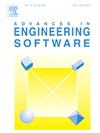结合节能Hamilton原理和稳定Newmark-β方法的三维车桥相互作用框架
IF 5.7
2区 工程技术
Q2 COMPUTER SCIENCE, INTERDISCIPLINARY APPLICATIONS
引用次数: 0
摘要
本研究提出了一种新的基于Hamilton原理的三维VBI (Vehicle-bridge interaction)系统建模框架,并结合改进的Newmark-β方法求解动力响应。通过考虑系统的动能和势能,汉密尔顿原理准确地描述了车辆和桥梁之间的耦合振动。通过建立欧拉-伯努利梁理论模型和车辆弹簧阻尼系统模型,推导了考虑三维路面不规则性和随机交通荷载的VBI系统动力学方程。耦合动力学方程保证了复杂交通荷载下的节能。采用改进的Newmark-β法求解非线性动力响应,保证了数值的稳定性和精度。理论验证表明,该模型在描述桥梁跨中位移和车辆竖向位移方面具有较好的准确性。数值模拟和实例比较进一步突出了汉密尔顿原理的优点。例如,在车速为40 km/h时,模拟的跨中位移与实测值的最大偏差仅为0.42 mm,决定系数(R²)达到0.92,平均绝对误差(MAE)显著降低至0.24。本文章由计算机程序翻译,如有差异,请以英文原文为准。
A 3D vehicle-bridge interaction framework integrating energy-conserving Hamilton’s principle and stabilized Newmark-β method
This study proposes a novel 3D (Three-dimensional) VBI (Vehicle-bridge interaction) system modeling framework based on Hamilton's principle, coupled with an improved Newmark-β method for solving dynamic responses. By considering the kinetic and potential energies of the system, Hamilton's principle accurately describes the coupled vibrations between vehicles and bridges. The dynamic equations of the VBI system are derived by constructing a Euler-Bernoulli beam theory models and vehicle a spring-damped system models, incorporating 3D road surface irregularities and random traffic loads. The coupled dynamic equations ensure energy conservation under complex traffic loads. An improved Newmark-β method is employed to solve the nonlinear dynamic responses, ensuring numerical stability and accuracy. Theoretical validation demonstrates the model's superior accuracy in describing bridge mid-span displacement and vehicle vertical displacement. Numerical simulations and case comparisons further highlight the advantages of Hamilton's principle. For example, at a vehicle speed of 40 km/h, the maximum deviation of the simulated mid-span displacement from the measured value is only 0.42 mm, with a coefficient of determination (R²) reaching 0.92 and the mean absolute error (MAE) significantly reduced to 0.24.
求助全文
通过发布文献求助,成功后即可免费获取论文全文。
去求助
来源期刊

Advances in Engineering Software
工程技术-计算机:跨学科应用
CiteScore
7.70
自引率
4.20%
发文量
169
审稿时长
37 days
期刊介绍:
The objective of this journal is to communicate recent and projected advances in computer-based engineering techniques. The fields covered include mechanical, aerospace, civil and environmental engineering, with an emphasis on research and development leading to practical problem-solving.
The scope of the journal includes:
• Innovative computational strategies and numerical algorithms for large-scale engineering problems
• Analysis and simulation techniques and systems
• Model and mesh generation
• Control of the accuracy, stability and efficiency of computational process
• Exploitation of new computing environments (eg distributed hetergeneous and collaborative computing)
• Advanced visualization techniques, virtual environments and prototyping
• Applications of AI, knowledge-based systems, computational intelligence, including fuzzy logic, neural networks and evolutionary computations
• Application of object-oriented technology to engineering problems
• Intelligent human computer interfaces
• Design automation, multidisciplinary design and optimization
• CAD, CAE and integrated process and product development systems
• Quality and reliability.
 求助内容:
求助内容: 应助结果提醒方式:
应助结果提醒方式:


